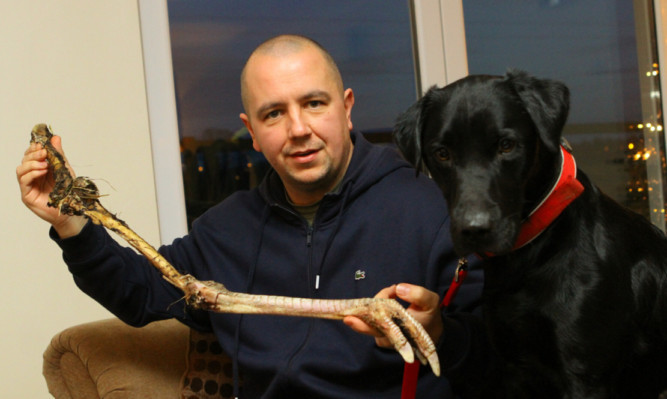MYSTERY CONTINUES to shroud the mutilated bird’s leg found by a dogwalker at an abandoned airfield.
It had seemed the riddle of the bird’s identity had been solved when a bird expert from the Camperdown Wildlife Centre said the limb was most likely to belong to a baby ostrich.
However, new theories then emerged with readers postulating that the foot actually belongs to a rhea, another member of the ratite family which is smaller than an ostrich.
James Moffat, from Fife, said: “It’s either a rhea or an emu. I used to breed ostriches and an ostrich only has two toes on each foot, even when it’s a chick.”
Mr Moffat, who used to own Fife Animal Park, said given the unpopularity of breeding ostriches, it was unlikely to be one of them.
“The meat didn’t really take off,” he said. “People in Britain didn’t really eat it.”
A spokeswoman for the RSPB said there are more ostriches than rheas to be found given the farming across the east of Scotland.
She said: “With just a leg to base identification on it is very difficult to say for certain as they (ostriches and rheas) are both members of the same diverse family of flightless birds, ratites.”
Another reader from the Forfar area said the three-toed foot could belong to one of the rheas which used to be kept in the grounds of Kookaburras Restaurant before it closed.
Children used to feed the rheas there and watch wallabies and emus out in the paddock.
However, if that was the case the limb would somehow have had to travel down the A90 to Tealing.
And in another twist to the tale it is now feared that a human could be responsible for the severed foot.
Sean Donaldson (39) made the discovery while walking his dog at the former airfield at Tealing. He believes the beast could have been mauled by a bigger animal but it is still unclear how it met its gruesome fate.
The Courier’s farming editor Ewan Pate said farmers in the area would be keen to discover if there was a predator on the loose which could bring down a bird of this scale.
But the RSPB spokeswoman last night speculated that a human could be behind the grissly find as ostriches have no natural predators in the UK.
She said: “There are no native wild animals in Britain which could kill the ostrich. They are incredibly strong birds who can disembowel potential predators.
“Purely speculation, but this bird could have been stolen from a farm and killed by a human or an off-cut of the carcass was thrown out by someone.”
ksmyth@thecourier.co.uk
